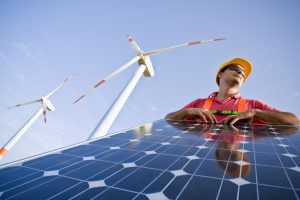Greentech Media’s Power & Renewables Summit takes place November 13-14, 2018 in Austin, Texas. The conference will gather industry views on how renewable integration, decarbonization and sector electrification are impacting electricity systems.

In the last month, a new report from the U.N. Intergovernmental Panel on Climate Change heightened the urgency of climate threats and the need for decisive actions to avoid them. The report “describes a world of worsening food shortages and wildfires and a mass die-off of coral reefs as soon as 2040.”
As I and other renewable energy insiders plan our talking points for Greentech Media’s “Power & Renewables Summit” in Austin next month, this report should serve as inspiration. The need for a clean, resilient energy economy just got a lot more salient.
For several years I’ve been writing about the pressing need to maximize renewable energy. California has been turning off solar generation. Wind energy in Texas isn’t used to its fullest extent, either. We see similar challenges in Hawaii, Germany and China, where renewables have grown quickly and are now a significant part of the electricity mix. Making sure we can use all of the renewable electricity we generate is among the most important challenges facing states and countries trying to reduce their carbon emissions.
The good news is that a little bit of flexibility can go a long way in helping smooth our transition to carbon-free electricity. In prior blogs, I’ve suggested better retail prices are part of the solution. Research sponsored by the California Air Resources Board indicates the state could save several hundred million dollars a year by better aligning electricity demand with solar generation.
California ISO (CAISO) has developed FERC-approved “flexible ramping” products that are 5- and 15-minute long tradable wholesale commodities. This allows innovative energy companies to get paid for helping customers store electricity or shift their demand away from times when the grid is stressed. Unfortunately, California continues to curtail massive quantities of renewable solar generation. The story is similar in other jurisdictions where variable renewable generation has grown significantly.
In Texas, wind power capacity is a massive success story, but it’s undercut by waste. Texas’ electric grid operator, the Electric Reliability Council of Texas (ERCOT),tracks wind development, noting that the “changing resource mix in the ERCOT region has presented unique challenges for grid operators.” Though wind curtailment was minor this past summer, more wind and solar capacity additions are anticipated, which could lead to waste if nothing is done to better align this growth with customer demand.
Fortunately, like California, there are attractive solutions for Texas, and for other areas where renewables have made the daily timing of electricity use a material matter. The Rocky Mountain Institute estimates that “demand flexibility” could save Texans billions. This is not rocket science, but it’s just as impressive. Imagine “tens of millions of demand flexibility assets” – things like water heaters, grid-responsive electric vehicles and regular household electric plugs – that can be used to help curb demand and better align it with renewable generation.
I’ll be speaking on a panel at the Greentech Media “Power & Renewables Summit” about the need for flexibility and the many exciting consumer-centric solutions this will involve. I hope to see you there.









